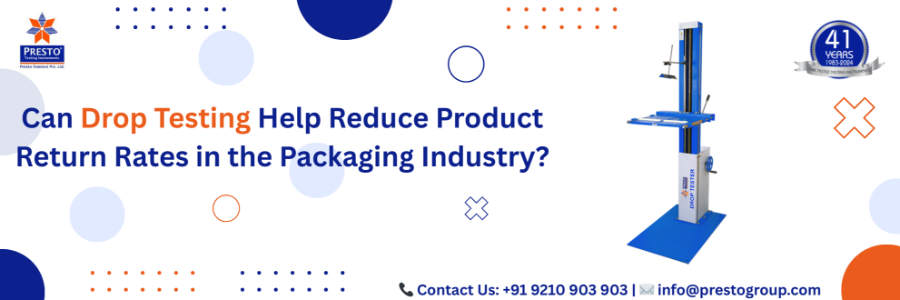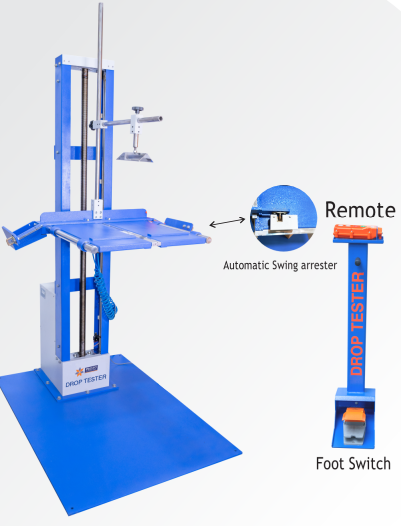Can Drop Testing Help Reduce Product Return Rates in the Packaging Industry?

Vishal Malhotra-Testing Instrument Expert
11-07-2025
In today’s fast-moving world of online shopping and global shipping, the packaging industry is super important for making sure products get to customers in perfect shape. But, damaged products during shipping is still a big problem, causing lots of returns, unhappy customers, and money losses. One great way to tackle this is drop testing, a method that mimic real-world shipping conditions to check how tough packaging really is. This blog dives into the importance of drop testers in the packaging industry, what drop strength tests on packages do, and how they can cut down on product returns.
What is Drop Testing?
Drop testing is when you drop packaged products from certain heights onto a hard surface to see how they hold up. It’s like copying what might happen during shipping—like if a warehouse worker drop a box or it gets bumped around during delivery. The goal is to check if the packaging can protect what’s inside. By finding weak spots early, companies can fix their packaging before products hit the market.
Drop testing follows rules, like ones from the International Safe Transit Association (ISTA) and ASTM International. These drop test standards make sure tests are done the same way every time, so results is reliable and meet customer or legal needs.
Why Drop Testing Matters in the Packaging Industry
The packaging world is under pressure to make strong, eco-friendly, and affordable solutions. A damaged product doesn’t just mean a return—it can hurt a company’s reputation and make customers lose trust. Here’s why the drop tester is a game-changer:
1. Identifying Packaging Weaknesses
Drop strength tests on packages show where packaging might fail. Maybe a box looks sturdy but can’t handle a corner drop. By catching these issues, companies can tweak their designs to make packaging tougher, which mean less damage during shipping.
2. Reducing Product Returns
Returns because of damaged goods are expensive—think replacement costs, shipping fees, and losing customers. Studies say e-commerce return rates can be 15% to 30%, with damage being a top reason. Drop testing make sure packaging can take a beating, cutting down on returns by keeping products safe.
3. Meeting Industry Standards
Following drop test standards like ISTA 1A, ISTA 3A, or ASTM D5276 show retailers, shippers, and customers that your packaging is legit. These standards set drop heights (usually 12 to 30 inches, depending on package weight) and test steps to mimic real handling. Sticking to them build trust and avoids fights over damaged shipments.
4. Enhancing Customer Satisfaction
When a product arrives in one piece, customers are happy, and that means more repeat buys and good reviews. Drop testing makes sure packaging do its job, protecting stuff from the warehouse to the customer’s door.
5. Supporting Sustainability Goals
Some companies over-pack to avoid damage, but that waste materials and hurts the environment. Drop testing helps find the sweet spot—using just enough material to keep products safe while being eco-friendly.
How Drop Strength Testers Work
A drop tester is a fancy machine that does controlled drops. You can set drop heights, angles, and surfaces to match real-world scenarios. Like, you might drop a box flat on its bottom, on a edge, or on a corner to see how it holds up.
Today’s drop testers are high-tech, with stuff like:
- Programmable drop sequences to act like real shipping conditions.
- High-speed cameras to watch how impacts happens.
- Data logging to keep track of test results for quality checks.
Using drop testers, companies can do the same tests over and over, making sure all their packaging work the same way.
Drop Test Standards and Heights
Drop test standards give a clear plan for testing how tough packaging is. Some common ones is:
- ISTA 1A: A basic test for packages up to 150 pounds, with drops from 12 to 30 inches based on weight.
- ISTA 3A: A bigger test for e-commerce packages, mimicking lots of handling situations, like drops, shakes, and squishing.
- ASTM D5276: A standard for drop tests that sets drop heights and angles based on package type and weight.
Drop test standard heights depends on the package. For example:
- Packages under 20 pounds might get dropped from 30 inches.
- Heavier ones (up to 150 pounds) use lower heights, like 12 inches, to match real-world handling.
These standards make sure packaging can handle typical shipping stresses, lowering the chance of damage.
The Impact of Drop Strength Tests on Product Returns
Drop strength tests on packages tackle one of the biggest reasons for returns: damage during shipping. By acting like real-world conditions, these tests help companies:-
- Optimize Packaging Design- Pick the right materials, cushioning, and supports to protect products.
- Cut down on over-packaging- Use less material to save money and help the planet.
- Improve Quality Control- Make sure all packaging performs the same across batches.
- Boost Supply Chain Efficiency- Fewer returns and replacements means smoother operations.

For instance, an electronics company might use a drop strength tester to make sure a fragile product, like a smartphone, stay safe in its box. By finding weak spots—like not enough cushioning or bad seals—they can fix things and cut down on cracked screens or broken parts, leading to less returns.
 (1).jpg)
Case Study: Drop Testing in Action
Take a big e-commerce retailer that had a 20% return rate on fragile home goods because of shipping damage. After using drop strength tests on packages with ISTA 3A rules, they redesigned their packaging with extra foam and stronger corners. Follow-up tests showed the packaging was way tougher, dropping the return rate to 8% in six months. This saved money and made customers happier, boosting brand loyalty.
Challenges and Considerations
The importance of drop testers in the packaging industry is clear, but there’s some hurdles:
- Cost of Equipment: Good drop testers isn’t cheap, though they save money in the long run by cutting returns.
- Testing Time: Thorough testing takes time, which can slow down getting products to market.
- Balancing Durability and Cost: Super-strong packaging can raise material and shipping costs, so you gotta find a balance.
To deal with these, companies can work with testing labs or get drop testers that fits their production needs.
The Future of Drop Testing in Packaging
With e-commerce booming, the need for tough, green packaging is only growing. New tech, like AI analyzing impact data or eco–friendly materials, will make drop testing even better. Combining drop tests with other tests, like vibration or compression, will give a fuller picture of how packaging hold up.
Final Word: Enhancing Packaging with Drop Testers
The drop tester is a key tool for the packaging industry, helping cut product return rates big time. By finding weak spots, meeting drop test standards, and improving packaging designs, companies can reduce damage, save money, and keep customers happy. Investing in drop testers and following standards like ISTA and ASTM turn packaging into a strength, not a problem. As the industry keep changing, the importance of drop testers in the packaging industry will stay a must-have for making sure products arrive safe and keep customers coming back.
Looking for the Best Drop Tester to Ensure Packaging Durability?
Trust Presto Group – India’s leading Drop Tester manufacturer and supplier, known for delivering precision-engineered testing solutions.
Call us at +91 9210 903 903 Email: info@prestogroup.com
Ensure your packaging meets the highest quality standards with Presto!
Recent News
- Paper & Packaging Testing Instruments
- Paint, Plating & Coating Testing Instruments
- Plastic & Polymer Testing Instruments
- Environmental Testing Chambers
- PET & Preform Testing Instruments
- Color Measuring Testing Instruments
- View Entire Range Instruments

Catalogue 2023
Get information about new product launches, research, innovation and endeavors at Presto.
download Free CopyNeed more information
Connect with us for your business enquiries. Generally we respond within one or two working days.
send enquiriesContact Us
Get a Quote
